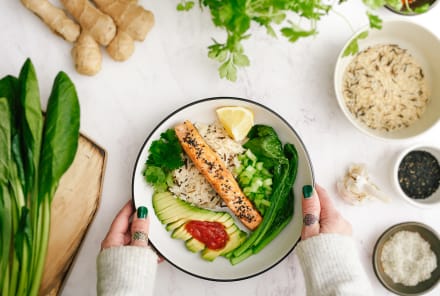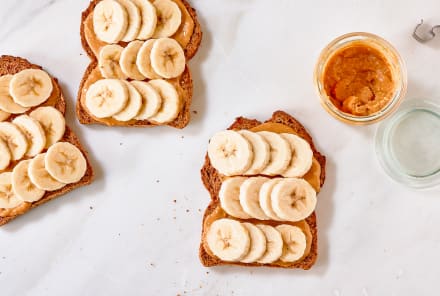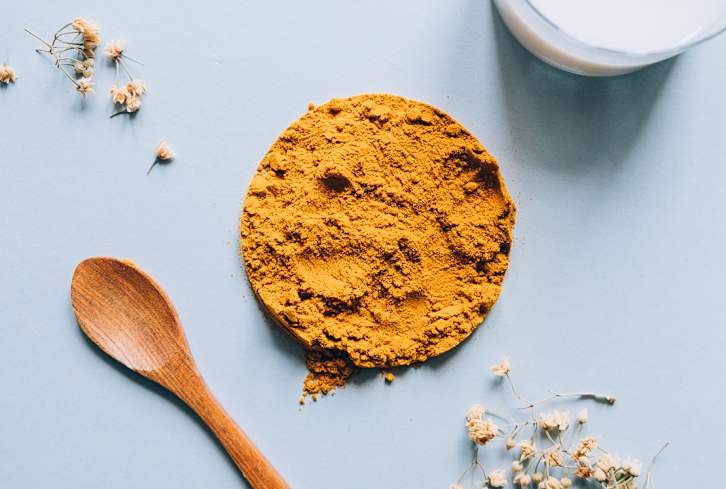Advertisement
8 Dietitians Share The Nutrition Advice They Actually Follow


As dietitians, people are often quite curious about what we put on our plates. We know so much about food and nutrition that every meal must be picture-perfect: Right? Not quite. But we do practice what we preach, and each of us has a few nonnegotiable healthy choices that are staples in our daily lives.
So I tapped eight dietitians for their top nutrition advice that they actually follow. Here's what they have to say.
Swap the salt for herbs and spices
"A universal habit many of us can relate to is topping meals with a heavy hand of table salt. Although many of us are aware that consuming too much is linked to an increased risk of heart disease, we still may have a hard time shaking the salt habit.
One piece of advice that was passed down to me by my mom was to boost flavor in meals with herbs and spice mixes instead of salt. They make healthy eating more enjoyable and diverse while also providing a dose of antioxidants. My spice drawer is filled with selections from different cuisines. For example, I always have a South Asian mix on hand that includes chili powder, turmeric, ground cumin, and coriander powder (like this Bhindi Masala recipe).
I like to use these mixes in marinades to flavor protein like salmon or roasted veggies. Surprisingly, the more I reduced salt intake, the more my taste buds became used to and drawn to natural flavors from herbs and spices."
No need to give up rice—just mix cauliflower in
"One of my favorite tips I love to tell my clients to do (and I do in my own life as well) is a simple cauliflower rice hack. Before you think I'm saying regular rice is bad, that actually is the exact opposite of this advice.
Because veggies and fiber can be one of the toughest things for most men and women to eat enough of, what I suggest when creating what I call 'bowl meals' at home (like taco bowls, for example) is to easily just mix brown or white rice with cauliflower rice as your base of the meal.
This is great because you are still getting the important starches for a balanced meal from the regular rice, but the addition of cauliflower is going to add more volume and easily sneak healthful veggies (and fiber) into your meal without it even feeling like you're trying.
And this hack is great for picky eaters (or even a picky spouse) as you can mask the flavor of the cauliflower rice within the burrito or Mediterranean bowl you're eating, for example!"
Make your own bone broth
"A healthy tip I follow myself is to make a big pot of bone broth every week to drink almost daily. Bone broth is packed with easily digestible protein and minerals. I use a whole chicken, beef tendon, and a ton of veggie scraps. I add in some Chinese medicinal herbal ingredients too like goji, Angelica root, and star anise to make the broth more functional. Scallions and whatever fresh herbs I have on hand are also a must.
I drink it whenever I want, to be honest. I usually have it in the morning before I leave the house, but sometimes I enjoy it in the evening too."
Prioritize protein
"Something that's been a game changer for me has been prioritizing protein. In my early 20s when I was living with a vegetarian boyfriend who made me feel guilty about wanting to eat eggs, poultry, fish, and meat, I found that I was tired and anxious a lot and had a hard time building muscle. Beans and tofu are great, but I didn't feel like myself when I was relying solely on plant-based options for protein.
Every body is different. In that phase of my life, I was ignoring the signals mine was trying to send me. Not cool. Even after we broke up, it took a while to shake that guilty mindset. It was actually when I was a dietetic intern at age 26 and super active running around the hospital that I started to crave protein intensely and became more intentional about eating enough.
When I began aiming to have 20 to 30 grams per meal and incorporated high-protein snacks, I found I had more energy, was able to build strength, and I also found that my mental health improved as well. More than a decade later, this is still a must for me. I embrace plant and animal-based sources of protein and honor what feels right for me."
Eat mindfully & don't forget supplements
"There are two nutrition habits I've been very mindful of lately.
Firstly, I finally started carving out more time this year to log off work and enjoy my lunch (instead of inhaling it and consuming it with semi-stressful distractions) to savor the flavors and nutrients while simultaneously reaping the appetite regulation benefits by letting my natural satiety hormone cascade kick in.
Secondly, I fill key nutrient gaps with high-quality supplements (with organic vitamin D3, triglyceride omega-3s via fish oil, and a comprehensive multivitamin) every day with intention, and have for a decade plus. But only recently did I start leaning into a daily fiber supplement regimen, to glean the unique benefits of key functional, prebiotic fibers with clinical research backing that I'm not regularly getting in my diet (e.g., organic guar beans, mushrooms, kiwi).
Aside from being super easy to incorporate into my life (I mix the unflavored fiber powder into my water or tea each day), the satiety and regularity benefits are heavenly. Fewer cravings, better poops—yes, please."
Dilute sweetened drinks
"A strategy I use to cut back on added sugars is diluting my carbonated beverages with water. Instead of opting for sugary sodas or flavored sparkling drinks, I mix carbonated beverages (I specifically love ginger ale) with plain water to reduce the sweetness while still enjoying the fizziness. This simple swap not only helps me decrease my sugar intake but also keeps me hydrated throughout the day, which is essential for optimal health and cognition. All fluids count!
I once cut out all carbonated beverages when I was in my real health freak phase, but I realized all things can be made enjoyable in moderation. I've tried flavored seltzers but find that either the aspartame or other sugar additives make it too sweet for me or sometimes cause GI upset.
By making these adjustments, I've noticed I don't binge on [sugary] beverages but still enjoy the taste."
Stock your kitchen with flavor enhancers and frozen berries
"I grew up on a farm and as a former model and finance professional, I became a dietitian to solve my own health issues and figure out how to lose weight while improving my metabolism. That being said, I make all of my meals myself and try to buy most of my food from local farmers or farms that use regenerative agricultural practices.
Here are two ways that I've mastered the art of healthy cooking while being a full-time entrepreneur and global wellness advocate:
First, I always make sure to keep flavor enhancers in my pantry for easy Mediterranean-style dishes that elevate the simplicity of my dishes. My favorites are capers, pickled onions, lemons, smoked salt, herbes de Provence, garlic, sun-dried tomatoes, and pickled cucumbers.
Secondly, I keep a lot of frozen berries in my fridge (cranberries, blueberries, cherries, raspberries) that I use for smoothies, or use them as a snack or a dessert, as a topping to sheep's milk yogurt, or collagen chia seed pudding."
Dress up plain Greek yogurt
"My most self-practiced dietitian advice is choosing plain Greek yogurt instead of flavored. Some yogurts pack upward of 17 grams of added sugars per serving (more than one Krispy Kreme glazed doughnut), which is absurd. While cutting out all added sugars isn't necessary or feasible for me, avoiding unnecessary sugars really helps your blood sugar, gut, and feelings of satiety.
So to do that (as well as reduce my grocery costs and food packaging waste), I currently only buy large containers of plain Greek yogurt. I started by adding a drizzle of maple syrup to it for my morning yogurt bowls. But I quickly grew to love the yogurt's tartness. Now, any flavored yogurt tastes cavity-inducingly sweet or leaves an odd aftertaste in my mouth. It's also so much more versatile to have plain Greek yogurt for other recipes than, say, vanilla."
The takeaway
Most of the tips we share here are ways to add flavor, color, and variety to meals to help you feel full while cutting back (not eliminating) things like excess salt and sugar. And most importantly, we all like these habits. We aren't sacrificing enjoyment in the name of health.
Of course, what works for us might not work for you. Eating should be personalized to your taste buds and goals. If you're unsure where to start, consider working one-on-one with a dietitian for individualized guidance.

5 Subtle Signs You Might Be Low In Omega-3 Fats & What To Do About It
Molly Knudsen, M.S., RDN

This Antioxidant-Rich Fruit Is A+ For Sleep & Recovery, Research Shows
Molly Knudsen, M.S., RDN

Which Is Healthier: One Drink Daily Or A Few Drinks On The Weekend?
Molly Knudsen, M.S., RDN

5 Subtle Signs You Might Be Low In Omega-3 Fats & What To Do About It
Molly Knudsen, M.S., RDN

This Antioxidant-Rich Fruit Is A+ For Sleep & Recovery, Research Shows
Molly Knudsen, M.S., RDN

Which Is Healthier: One Drink Daily Or A Few Drinks On The Weekend?
Molly Knudsen, M.S., RDN

5 Subtle Signs You Might Be Low In Omega-3 Fats & What To Do About It
Molly Knudsen, M.S., RDN

This Antioxidant-Rich Fruit Is A+ For Sleep & Recovery, Research Shows
Molly Knudsen, M.S., RDN

Which Is Healthier: One Drink Daily Or A Few Drinks On The Weekend?
Molly Knudsen, M.S., RDN

5 Subtle Signs You Might Be Low In Omega-3 Fats & What To Do About It
Molly Knudsen, M.S., RDN

This Antioxidant-Rich Fruit Is A+ For Sleep & Recovery, Research Shows
Molly Knudsen, M.S., RDN

Which Is Healthier: One Drink Daily Or A Few Drinks On The Weekend?
Molly Knudsen, M.S., RDN












